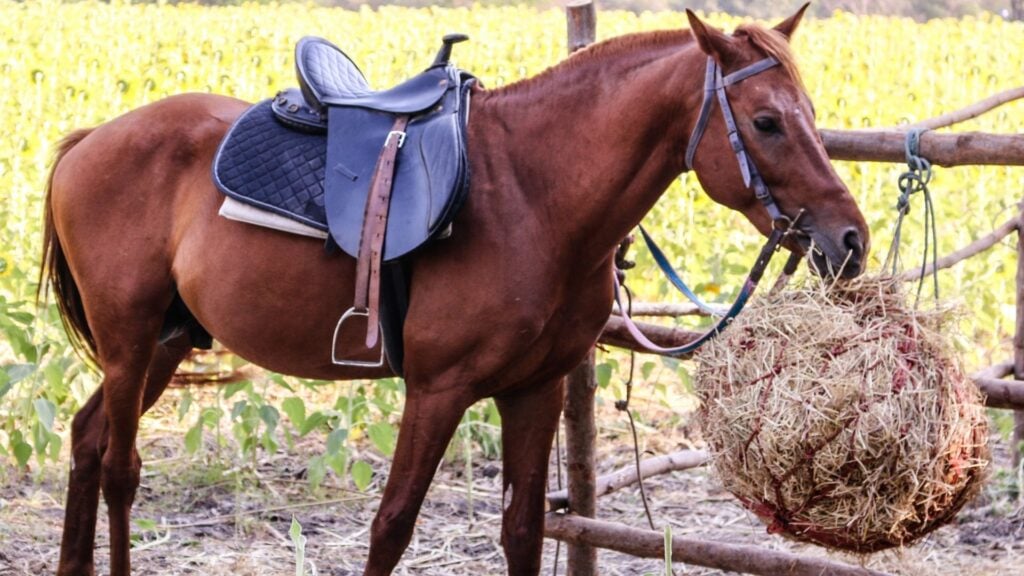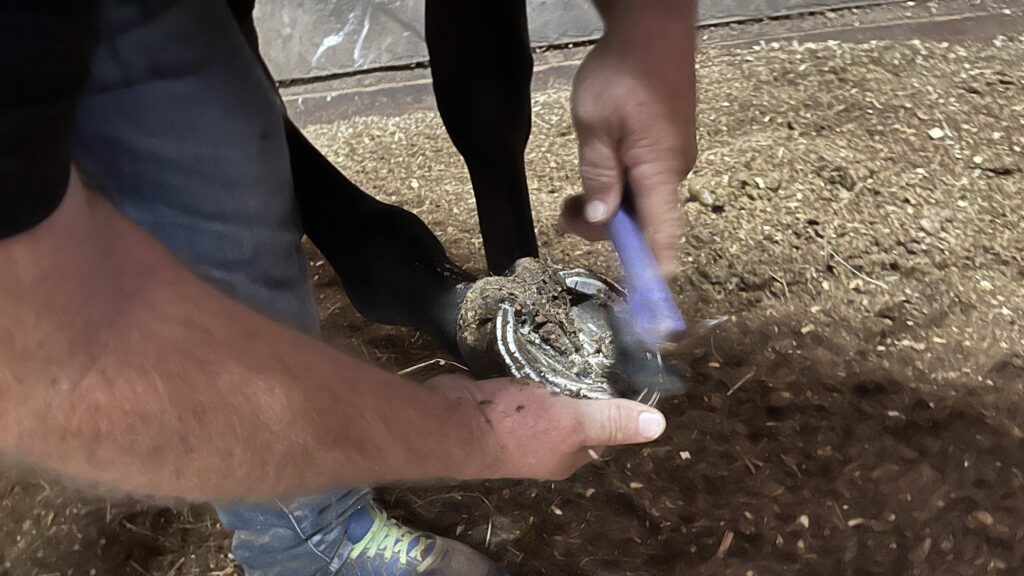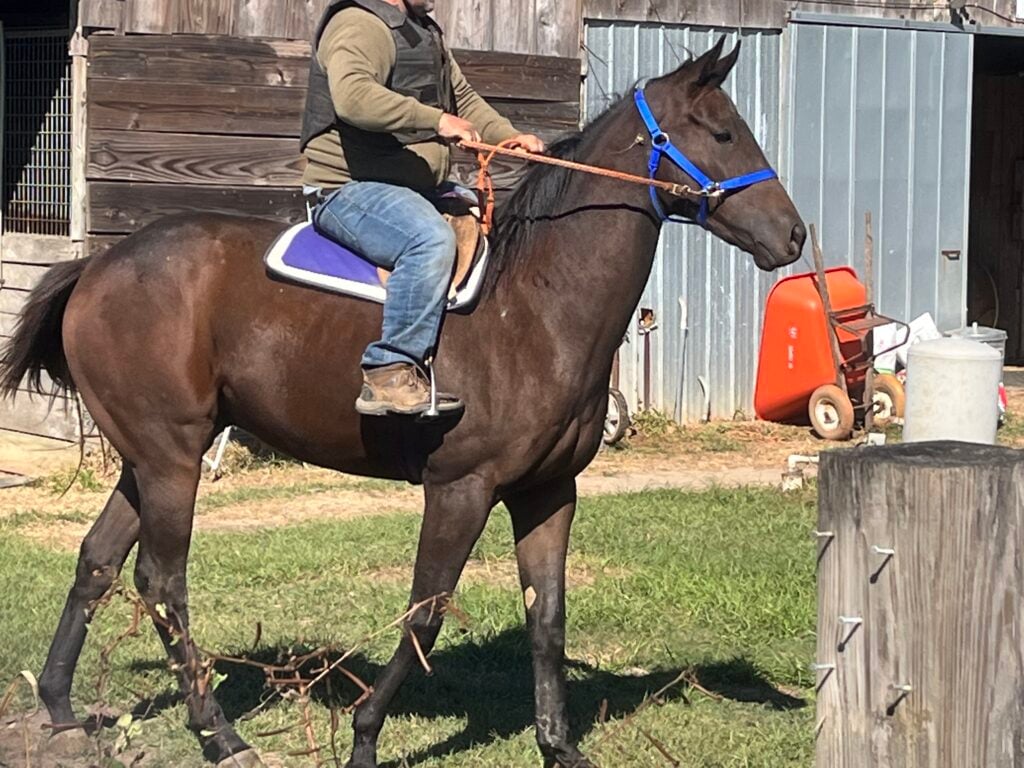Last updated: December 28, 2022
Any links on this page that lead to products on Amazon are affiliate links and I earn a commission if you make a purchase. Thanks in advance – I really appreciate it!
Many people are interested in owning horses but aren’t knowledgeable when it comes to caring for them. I often hear, “I would love to have a horse, but I just don’t have enough time to care for one.” Taking care of a horse is a big responsibility, but it’s not too difficult or time-consuming.
The daily care for horses includes:
- Rinsing and refilling the water buckets.
- Feeding them hay or grain.
- Brushing their coat to remove any accumulated dirt.
- Picking their hoofs.
- Checking for injuries.
These tasks typically take about thirty minutes if everything goes smoothly.
The type of horse and its activity are significant factors in how much care they need and the time you invest. Some people have to spend hours every day, while others might only spend minutes or less taking care of their horses.

Daily horse care for beginners
A horse is a big responsibility, but the rewards of caring for one are worth it. A part of being responsible includes feeding and grooming your horse to ensure that they stay healthy, happy, and lives a long life.
The following passages cover essential horse care tips tailored explicitly towards beginners, such as feeding and grooming techniques to ensure your animal is properly cared for.
Horses are individuals and need different levels of care, but there are some basic guidelines you should follow.
Feeding your horse
Horses are herbivorous and must consume forages such as hay or grass to maintain their sensitive digestive system. They should consume between one and two percent of their body weight daily in forage.
It would be best if you tailored your horse’s diet to its needs. Horses that work hard typically need extra calories and protein. I recommend supplementing their diet with at least one scoop of high-quality sweet feed.

What Do Horses Eat? An Equine Nutrition Guide
When you’re determining how to feed your horse, you should consider various factors. Such as whether it’s kept in a stall or spends most of its time on pasture.
Horses are not creatures made for the indoors. They love to graze on grass, roam in fields, and socialize with other horses. If possible, turn them out daily in a pasture with quality grass.
If pasture grass isn’t an option, you must supply ample amounts of hay. Hay is one of the most overlooked and valuable resources that any horse owner can have.
But it’s important to note that not all hay is the same. Some excellent grass and legumes used to make hay are Timothy, Orchardgrass, and Alfalfa. Learning about the different types of hay is essential because some will be better for your horse’s needs than others.
You have to store hay carefully to prevent the loss of nutrients and avoid mold and pests such as mice or rats that transfer diseases.
Ensure your horse has clean fresh water each morning and evening.
Feeding hay
My friends and I recently discussed whether it’s best to feed hay from a hay rack or on the stall floor. I prefer letting my horse eat off the ground because they’re used to grazing, which is how nature intended animals like these to eat.

Horse Hay: An Owner’s Guide
However, my friend thinks feeding hay from a rack is better because it keeps the hay clean, and there is less waste from it mixing with the shavings. Who’s right? I think either is good, so long as you feed your horse an adequate amount.
Horses have a unique digestive system that is best suited for the constant consumption of hay. For most people feeding their horse more than twice a day is impractical, so one way to get around this is to put hay in a slow feeder.
With slow-feeders, your horse won’t gobble its hay quickly – which keeps its digestive system working the way it’s meant to and reduces the risk of ulcers forming.
An average 1,000-pound horse needs about 12-15 pounds of high quality every day; if they are outside most of the time or at least have access to pasture during daylight hours, then less hay is needed.
Grooming
Horse grooming is a key part of taking care of your horse. It maintains optimum health and provides essential benefits such as preventing hoof rot, improving blood circulation and stimulating the release of natural oils needed to keep hair healthy.

Step-by-Step Horse Grooming: The Beginner’s Guide
Start your daily grooming with hoof cleaning. This task can be time-consuming and involves picking dirt and debris out from their hoofs with a hoof pick. Clean around the frog, trace around the inside of the shoe, or for unshod horses, clean where the sole meets the wall at the bottom of the foot.
Next, brush your horse with a curry comb to loosen dirt and debris. Use a circular motion and work from rear to front for best results. Once this is completed, go over them again using a soft brush to remove any dirt or debris you loosened up with the curry comb.
Check your horse for injuries or illness.

There are many ways to check for injuries. When brushing your horse, lookout for skin diseases and watch their reaction; sometimes, our horses let us know they’re injured when the brush hits a sore spot.
When you reach down to lift your horse’s feet rub its leg tendons to feel for heat which is a sign of inflammation, and push on its sole to check for abscesses. Check your horse for runny eyes and a snotty nose, and listen for wheezing or coughing.
On top of the basic steps, there are other ones you need to take weekly and monthly. For example, you should check your horse’s teeth and groom its mane and tail weekly.
Mucking out the stall
I typically move my horse to a walker and exercise her after she eats. While she is on the walker, I wash out her water bucket and muck out the stall.
We use pine shaving, so I take my shavings fork, pick up the manure and wet shaving, put it in a wheelbarrow, and dump it in our manure pile. This is a quick and easy job if you keep up with your stall cleaning.
How Much Time is Required to Care for Your Horse Daily?
I spend hours taking care of our horses each day but is all this time really necessary? The amount of time it takes to care for your horse daily will depend on your horse and routine.
In general, you should be able to complete your horses’ daily care in under an hour and often close to 30 minutes. Getting into a routine is important; it’s good for your horse and helps you complete your tasks much more quickly.
Some horse owners enjoy taking their time and giving extra attention to their horses in the morning. I’m one of these people, but if necessary, then I can quickly care for my horses within thirty minutes or less.
Preparing your horse to ride
When we plan to ride our horses in the morning, I don’t break their morning routine; I feed them at the same time, groom them, and put them on the walker.

Why Do You Need to Brush a Horse Before and After Riding?
Once I finish mucking out their stall, I bring them back to the barn and secure them. If you have a horse with a lot of morning energy, you may want to lunge it. Since we put ours on a walker, they usually are warmed up and ready to go.
Except for my grandson’s quarter horse, he is cold-backed. A cold-backed horse is one that bucks when a person first mounts it. We’ve tried various methods to break him of the habit but have yet to figure it out, so for now, an adult mounts the horse before my grandson gets on to ride.
When it comes to tacking your horse, you’re going to start by tying the animal so it won’t escape, then you need to brush its coat. Next, put on your saddle blanket, then the saddle, and tighten the cinch. Put the bridle on, make any adjustments, and mount your horse.
Caring for your horse after riding.
Cool your horse down and let it drink a little bit of water. Loosen the tack and let it continue to cool and walk the horse for about ten minutes, then offer it more water.
Next, we remove the tack and brush the horse to loosen dirt and fluff the sweaty hair; it’s also good practice to pick their feet at this time. We always bathe our racehorses after a workout and pay special attention to their legs and breathing.
Once the horse has been bathed and everything seems normal, we either turn him out in the pasture or put him in the stall with a bucket of feed, fresh water, and a few flakes of hay.
Below is a daily horse care YouTube video you may find helpful.
FAQ
What horses need to survive.
Horses only need two things to survive, water and forage. Horses are hardy; they proved this by surviving thousands of years without any help from humans. But even though wild horses live in harsh climates such as deserts and mountains, their numbers continue to grow.
Are horses hard to care for?
In general, horses aren’t hard to care for, but they do require a commitment. You have to check on them daily and spend time feeding and grooming them.

About the Author: Miles Henry
Lifelong Horseman | Racehorse Owner | Published Author
Miles Henry brings over 25 years of hands-on experience training and owning Thoroughbred racehorses. Raised with Quarter Horses and Appaloosas, he’s spent a lifetime learning from horses—on the track, in the barn, and in the field. Today, he runs a small but successful racing stable in Louisiana and shares real-world insights on HorseRacingSense.com, helping horse owners, fans, and bettors navigate the sport with confidence.
📚 Books: View Miles’s books on Amazon »
🎧 Podcast Guest: Animal Tales Ep. 32 |
YouTube Interview
📩 Newsletter: Sign up for racing tips and horse care advice »
🔗 Follow Miles:
Twitter |
Facebook |
YouTube


